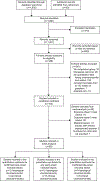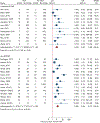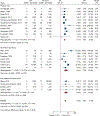Chorioamnionitis and Risk for Maternal and Neonatal Sepsis: A Systematic Review and Meta-analysis
- PMID: 33957655
- PMCID: PMC8905581
- DOI: 10.1097/AOG.0000000000004377
Chorioamnionitis and Risk for Maternal and Neonatal Sepsis: A Systematic Review and Meta-analysis
Abstract
Objective: To estimate the risk of maternal and neonatal sepsis associated with chorioamnionitis.
Data sources: PubMed, BIOSIS, and ClinicalTrials.gov databases were systematically searched for full-text articles in English from inception until May 11, 2020.
Methods of study selection: We screened 1,251 studies. Randomized controlled trials, case-control, or cohort studies quantifying a relationship between chorioamnionitis and sepsis in mothers (postpartum) or neonates born at greater than 22 weeks of gestation were eligible. Studies were grouped for meta-analyses according to exposures of histologic or clinical chorioamnionitis and outcomes of maternal or neonatal sepsis.
Tabulation, integration, and results: One hundred three studies were included, and 55 met criteria for meta-analysis (39 studies of preterm neonates, 10 studies of general populations of preterm and term neonates, and six studies of late preterm and term neonates). Study details and quantitative data were abstracted. Random-effects models were used to generate pooled odds ratios (ORs); most studies only reported unadjusted results. Histologic chorioamnionitis was associated with confirmed and any early-onset neonatal sepsis (unadjusted pooled ORs 4.42 [95% CI 2.68-7.29] and 5.88 [95% CI 3.68-9.41], respectively). Clinical chorioamnionitis was also associated with confirmed and any early-onset neonatal sepsis (unadjusted pooled ORs 6.82 [95% CI 4.93-9.45] and 3.90 [95% CI 2.74-5.55], respectively). Additionally, histologic and clinical chorioamnionitis were each associated with higher odds of late-onset sepsis in preterm neonates. Confirmed sepsis incidence was 7% (early-onset) and 22% (late-onset) for histologic and 6% (early-onset) and 26% (late-onset) for clinical chorioamnionitis-exposed neonates. Three studies evaluated chorioamnionitis and maternal sepsis and were inconclusive.
Conclusion: Both histologic and clinical chorioamnionitis were associated with early- and late-onset sepsis in neonates. Overall, our findings support current guidelines for preventative neonatal care. There was insufficient evidence to determine the association between chorioamnionitis and maternal sepsis.
Systematic review registration: PROSPERO, CRD42020156812.
Copyright © 2021 by the American College of Obstetricians and Gynecologists. Published by Wolters Kluwer Health, Inc. All rights reserved.
Conflict of interest statement
Financial Disclosure The authors did not report any potential conflicts of interest.
Figures






References
Publication types
MeSH terms
Grants and funding
LinkOut - more resources
Full Text Sources
Other Literature Sources
Research Materials
Miscellaneous

